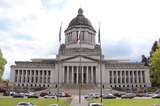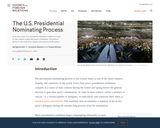Introduction
The presidential nominating process in the United States is one of the most complex, lengthy, and expensive in the world. Every four years, presidential candidates compete in a series of state contests during the winter and spring before the general election to gain their party’s nomination. At stake in each contest—either a primary or caucus—is a certain number of delegates, or individuals who represent their states at national party conventions. The candidate who accumulates a majority of his or her party’s delegates during the months-long process wins the nomination.
Many presidential candidates begin campaigning informally in early-voting states like Iowa and New Hampshire more than a year before their primary events. In 2016, the primary calendar kicked off on February 1, when both the Republican and Democratic parties held their Iowa caucuses, and ends at the national conventions in July, when party delegates officially select their nominee. However, since the parties made the process more transparent in the 1970s, presumptive nominees have often emerged much earlier, sometimes only after a few weeks of voting.
What is a caucus?
Often held at school gyms, town halls, and other public venues, caucuses are local meetings that are financed and managed by the two major parties in which registered party members gather to discuss and express support for the various presidential candidates. The parties run their events a little differently. For instance, in Iowa in 2016, Republicans cast a secret ballot for their preferred candidate, while Democrats physically grouped themselves according to the candidate they supported and then took a tally. Democratic candidates must attract a minimum percentage of all the attendees to receive delegates. (Reformers in the 1970s introduced a viability threshold to weed out smaller, potentially divisive factions.)
Caucus participants are technically not choosing a presidential candidate but rather choosing delegates who will represent them in voting for their candidate at the next convention level (county, congressional district, and state) where a similar process takes place. Delegates for the national convention are selected at the state and congressional district conventions.
The caucus system (PDF) did not develop to serve a modern presidential nomination process but arose in many jurisdictions simply to help the political parties organize at the local level. Parties in states like Iowa, where caucuses are held every two years, still see the value in this grassroots system, even as most states have adopted primaries.
What is a primary?
Unlike caucuses, primaries are conducted at regular polling stations, usually paid for by the state and run by state election officials. Voters generally cast a secret ballot for their preferred candidate.
Generally, there are two types of primaries: closed, in which only voters registered with the party holding the primary can participate; and open, in which voters are not required to be registered with the party holding the primary.
Prior to the 1970s, the majority of states chose their delegates using caucuses, but after reforms were instituted in 1972 to make the nomination process more inclusive and transparent most states adopted primaries.
In 2016, just fourteen states (Alaska, Colorado, Hawaii, Idaho, Iowa, Kansas, Kentucky, Maine, Minnesota, Nebraska, Nevada, North Dakota, Washington, and Wyoming), the District of Columbia, and four U.S. territories (American Samoa, Northern Marianas, Puerto Rico, and the U.S. Virgin Islands) hold caucuses.
Why have the Iowa caucuses become so important?
A number of factors in the 1970s pushed the Iowa caucuses into the national political spotlight. First, the Democratic Party instituted reforms after its 1968 national convention in Chicago, where days of antiwar protests erupted into violence, to limit the power of party bosses and open the nomination process up to regular members. Among other things, new guidelines required state delegates to be selected within the year of the general election, which, for Iowa, meant bumping its caucuses in 1972 up from March or April, when they were typically held, to January, ahead of the New Hampshire primary. (The party needed the extra several weeks to print its rules and other caucus materials for attendees.)
Four years later, Jimmy Carter, then a little-known former governor of Georgia, took advantage of Iowa’s first-in-the-nation contest by using a surprise early win there as a springboard onto the national stage. He led a similar grassroots campaign in New Hampshire where he notched another unexpected victory.
The strategic success of Carter’s campaign helped cement the special status of the two states in the presidential nomination process, even though the number of delegates at stake in each is relatively small. In 1980, the Democratic Party changed its rules to effectively preserve Iowa’s and New Hampshire’s early positions in the nomination process, and the Republican Party followed suit.
How will the delegate process work in 2016?
In recent decades, states have competed with each other to hold primaries and caucuses earlier in the calendar—in a phenomenon known as front-loading—to draw the attention of candidates and the national media. However, the political parties have set rules in recent years to discourage front-loading and provide states that hold events later in the spring a greater role in the nomination process.
In 2016, both parties allow just four states to hold their delegate selection event in February: Iowa, New Hampshire, Nevada, and South Carolina. The remaining states and territories must wait to hold events until at least March 1. (In 2016, more than a dozen states hold events on this day, commonly referred to as Super Tuesday.)
Additionally, the Republican Party requires states with contests before March 15 to award delegates on a proportional basis rather than the winner-take-all method preferred by many state party officials. (In 2016, Florida and Ohio host the first winner-take-all contests on this day.)
Who are the delegates?
Delegates are often party activists, local political leaders, or early supporters of a given candidate. Presidential campaigns court local and state politicians for their slate of delegates because they typically bring the support of their political constituencies. Delegates can also include members of a campaign's steering committee or long-time active members of their local party organization.
How do candidates win delegates?
On the Democratic side, candidates are generally awarded delegates on a proportional basis. For instance, a candidate who receives one-third of the vote or support in a given primary or caucus receives roughly one-third of the delegates.
The rules on the Republican side are more varied. Some states award delegates on a proportional basis, some are winner-take-all (ten in 2016), while others use a hybrid system. In previous cycles, some events, including the Iowa caucus, awarded no delegates and were intended only to assess the preferences of the party faithful. Rule changes for 2016 forced states to scrap these non-binding events, sometimes called “beauty contests.”
How is the turnout for these events?
Generally the turnout in caucuses tends to be lower than in primaries. In 2012, when only the Republican nomination was contested, 6.5 percent of all eligible voters in Iowa (but approximately 20 percent of registered Republicans) participated in the state’s caucuses. (This number was 16 percent in 2016 when both parties had competitive campaigns.) In comparison, the turnout in the New Hampshire primary was 31 percent. (Turnout rates were roughly 70 percent for both states for the 2012 general election.)
How many delegates are at stake?
In 2016, a Democratic candidate must secure at least 2,382 out of 4,763 delegates to become the party’s nominee. The number of delegates allocated to each state takes into account the state’s Democratic vote in the previous three presidential elections and its assigned number of Electoral College votes.
Meanwhile, a Republican candidate must secure at least 1,237 out of 2,472 delegates to win the party’s nomination. The Republican Party allocates each state ten delegates, plus three for each congressional district, and bonus delegates for states that contributed electoral votes to the party in the previous presidential election, as well those that elected Republicans to high offices.
What are superdelegates?
Each party also reserves a certain number of delegate slots for its high-ranking officials, who generally are not bound (or are “unpledged”) to a specific candidate heading into the national convention (unlike pledged delegates). On the Republican side, these include the three members of each state’s national committee, representing less than 7 percent of party’s total delegates in 2016. (The Republican Party has instructed state delegations to bind RNC members based on voting results.)
On the Democratic side, superdelegates include not only members of the national committee, but all members of Congress and governors, former presidents and vice presidents, former leaders of the Senate and the House, and former chairs of the Democratic National Committee. This group represents about 15 percent of the party’s total delegates in 2016.
The Democratic Party’s superdelegates attracted significant media attention during the 2008 presidential primary, when then Sen. Barack Obama and Sen. Hillary Clinton were engaged in a tight nomination race that carried on until June. Many thought that superdelegates, which accounted for about 20 percent of the party’s total that cycle, would be decisive in determining the nominee.
What role can independents play?
Because independent voters are unaffiliated with any party, they do not as a group receive delegates or hold their own national nominating convention or meeting. However, many states hold so-called open primaries that allow independents to participate. And some states allow voters to switch their party affiliation the day before an election, so that independents could register as a Republican or Democrat if they support a specific candidate.
Third parties, like the Green Party, can pick delegates for their own conventions. But because third-party candidates rarely earn a large percentage of the primary vote, the candidates their delegates select tend to garner little national attention.
What happens at the national conventions?
In recent decades, the national conventions have been mostly ceremonial, simply ratifying the candidate who has secured the support of a majority of delegates. They are generally organized as media events to highlight the presidential and vice presidential nominees, party leaders, and rising stars. Over a period of three to four days, speeches and videos promoting the party’s message are interwoven with official business, including the appointment of committee members, and ratification of party rules, credentials, and policy platforms.
However, in the rare presidential election cycle in which a clear frontrunner for either party does not emerge during the primary and caucus process, which last occurred in 1952, several rounds of voting at the national convention may be needed to crown a nominee. Pledged delegates are generally required to vote for a specific candidate in the first ballot (unpledged are not), but they may be allowed to vote for any candidate in subsequent ballots.
https://www.cfr.org/backgrounder/us-presidential-nominating-process


